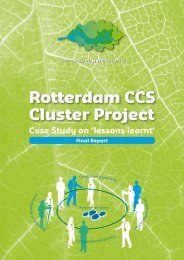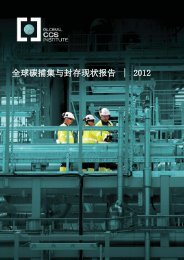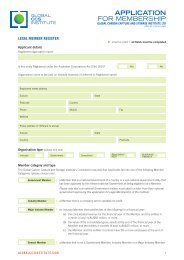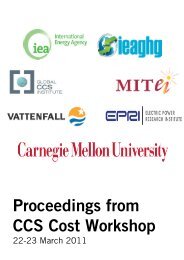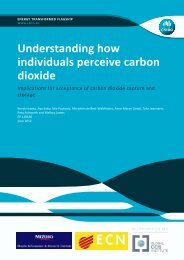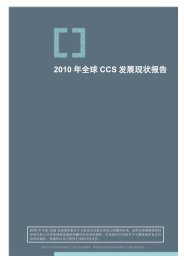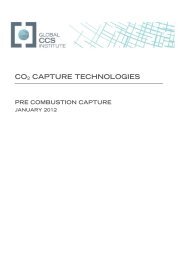- Page 1 and 2:
www.csiro.auA deployment strategy f
- Page 3:
Response to referee’s commentsThi
- Page 6 and 7:
This project identified the followi
- Page 8:
4.2.3 Marine electromagnetics . . .
- Page 12 and 13:
This page intentionally left blank.
- Page 14 and 15:
This page intentionally left blank.
- Page 16 and 17:
This page intentionally left blank.
- Page 18 and 19:
and Hoversten, 2006, 2005; Wells et
- Page 20:
Fundamentally, CO 2 detectability i
- Page 24 and 25:
which rises. Eke et al. (2011) reco
- Page 26 and 27:
• Rock physics uncertainties are
- Page 28 and 29:
2.1 South West Hub CCS ProjectThe S
- Page 30 and 31:
2.1.2 Data reviewPublically-availab
- Page 32 and 33:
GSWA Record 2004/8Gravity and magne
- Page 34 and 35:
−32˚30'115˚30'116˚00'−32˚30
- Page 36 and 37:
0cdp100 200 300 400 500 600 700 800
- Page 38 and 39:
W
- Page 40 and 41:
Figure 2.12: The Seaspray depressio
- Page 42 and 43:
2.2.2 Data reviewAs might be expect
- Page 45 and 46:
0South-WestNorth-East2depth (km)46F
- Page 47 and 48:
3 Rock physics relationshipsNo exta
- Page 49 and 50:
For the reservoir member a porosity
- Page 51 and 52:
3.1.2 Clean sandstone modelThe foll
- Page 53 and 54:
3.2 Electrical propertiesThe model
- Page 55 and 56:
300Lesueur project GEMTIP Rock phys
- Page 57 and 58:
4 Geophysical remote sensing techni
- Page 59 and 60:
0500100021.81.61.4 T (ms) 150
- Page 61 and 62:
108A S/A N64202000 2100 2200 2300 2
- Page 63 and 64:
Figure 4.5: The seismic lines super
- Page 65 and 66:
4.1.2 Data processingThe end goal o
- Page 67 and 68:
4.1.3 1D Reflection seismicsSeismic
- Page 69 and 70:
the detectability of CO 2 when only
- Page 71 and 72: 4.1.4 2D Reflection seismicsModelli
- Page 73 and 74: (a) Baseline velocity model(b) Velo
- Page 75 and 76: (a) Baseline and 2.5% CO 2 saturati
- Page 77 and 78: • ρ = 2.497g/cm 3 .This gives th
- Page 79 and 80: !me$(ms)$Figure 4.17: Noise-free ba
- Page 81 and 82: CDP0400 time (ms)800120016002
- Page 83 and 84: 5004504000.64kt1.59kt3.18kt6.37kt12
- Page 85 and 86: 010020040060080014000.116001800N ra
- Page 87 and 88: Figure 4.27: Zoomed in synthetic ba
- Page 89 and 90: Figure 4.30: Zoomed view of the inj
- Page 91 and 92: 4.1.6 Permanent receiver installati
- Page 93 and 94: Figure 4.33: Well 6, Zero-offset (1
- Page 95 and 96: 4.1.6.2 Ocean bottom cablesFor mari
- Page 97 and 98: 4.2 Electromagnetic surveying & int
- Page 99 and 100: • Clearly, the induction monitori
- Page 101 and 102: Key points to consider for applicat
- Page 103 and 104: 4.2.2.1 Single-borehole electromagn
- Page 105 and 106: 4.2.2.2 Separated-borehole electrom
- Page 107 and 108: The second and third examples of cr
- Page 109 and 110: 0 A 100 m 50010001500 2000 250010
- Page 111 and 112: 0Wonnerup, 1000 m target; Tx 1200m
- Page 113 and 114: Downloaded 23 Sep 2010 to 130.116.1
- Page 115 and 116: ceiver offset from the transmitter
- Page 117 and 118: Figure 4.50: Dependence of mCSEM re
- Page 119 and 120: The second variation of Figure 4.48
- Page 121: 0 A EE Component0B E Z Component0 C
- Page 125 and 126: 0 A EE Component0B E Z Component0 C
- Page 127 and 128: 4.2.4 Ground electromagneticsThe mC
- Page 129 and 130: Table 4.7: LOTEM Gate parameters. T
- Page 131 and 132: Response Background1.0101.0051.000
- Page 133 and 134: Response Background1.101.051.000.9
- Page 135 and 136: Primary Industries, 2011). However,
- Page 137 and 138: Effect of drill hole offset0DDH10DD
- Page 139 and 140: Microseismic monitoring ideally beg
- Page 141 and 142: ferromagnetic magnet which has a te
- Page 143 and 144: 5 Monitoring & verification strateg
- Page 145 and 146: 5.1 General recommendations & strat
- Page 147 and 148: Table 5.2: Suitability of geophysic
- Page 149 and 150: confused with seepage. In this case
- Page 151 and 152: 6 ConclusionsThis report has discus
- Page 153 and 154: 7 Recommendations for future resear
- Page 155 and 156: ReferencesAl-Ali, Z. A., M. H. Al-B
- Page 157 and 158: Du, J., D. L. Tilbrook, J. C. Macfa
- Page 159 and 160: JafarGandomi, A., and A. Curtis, 20
- Page 161 and 162: Schilling, F., G. Borm, H. Würdema
- Page 163 and 164: Yan, W., S. Huang, and E. H. Stenby
- Page 165 and 166: ACO 2 PropertiesThis Appendix gives
- Page 167 and 168: BSeismic preprocessing workflowThe
- Page 169 and 170: CSeismic data processing for quanti
- Page 171 and 172: Preprocessing prior to any stack wi
- Page 173 and 174:
Recent developments, such as target
- Page 175 and 176:
and should not be used for quantita
- Page 177 and 178:
DGeophysical software used in the p
- Page 179:
EProject detailsThis section lists




